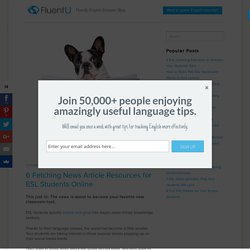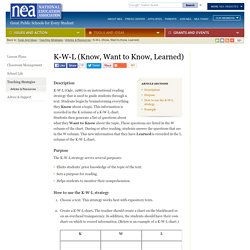

The Learning Network. Articles & Questions - The New York Times. 6 Exceptional Online News Article Resources for ESL Students. This just in: The news is about to become your favorite new classroom tool.

ESL students quickly evolve and grow into eager, news-thirsty knowledge seekers. Thanks to their language classes, the world has become a little smaller. Your students are taking interest in those popular stories popping up on their social media feeds. They want to know more about the world around them, and they want to use their new English skills to fuel their insatiable desire to learn.
Your ESL students may be developing in-depth questions and may start to ask you about local and global news. Give them the knowledge they yearn for. Which ESL News Articles Should I Choose for My Students? There are thousands of online news resources out there to choose from, often making the selection process seem difficult. You can type in a few key words relating to a trending news story and find multiple articles, online news resources and broadcast clips with a click of the mouse.
Monthly topical news lessons. Monthly news lessons are sourced from The Guardian, onestopenglish's principal news partner, and include topical news items with worksheets for you to use in class. The lessons in this section are available at pre-intermediate/intermediate, upper intermediate and advanced levels. All the articles are from the Guardian, onestopenglish's principal news partner.
As well as using the language exercises which accompany each article, you can exploit these news texts in a number of ways: as extra reading, especially for advanced students;by asking students to compare the political slant of different news organizations;as a way to start projects on the issues covered, etc. Please note: All news lessons are available on the site for a full year from the date of publication. Monthly news lesson: Why do we gender AI? Monthly news lessons are sourced from The Guardian, onestopenglish's principal news partner, and include topical news items with worksheets for you to use in class. Read, listen & learn a littleEnglish. Byrdseed: Gifted Education. Curriculet.
Cornell NoteTaking System. Anticipation Guide. K-W-L (Know, Want to Know, Learned) Description K-W-L (Ogle, 1986) is an instructional reading strategy that is used to guide students through a text.

Students begin by brainstorming everything they Know about a topic. This information is recorded in the K column of a K-W-L chart. Students then generate a list of questions about what they Want to Know about the topic. These questions are listed in the W column of the chart. Purpose The K-W-L strategy serves several purposes: Elicits students’ prior knowledge of the topic of the text. How to use the K-W-L strategy Choose a text. Ogle, D.M. 1986. Example Following is an example of a completed K-W-L chart that students might complete if they were reading a text about gravity. Topic: GRAVITY * The students’ question about Newton was not answered in the text. 11 Alternatives to "Round Robin" (and "Popcorn") Reading.
Round robin reading (RRR) has been a classroom staple for over 200 years and an activity that over half of K–8 teachers report using in one of its many forms, such as popcorn reading.

RRR’s popularity endures despite the evidence that the practice is ineffective for its stated purpose: enhancing fluency, word decoding, and comprehension. Cecile Somme makes a good point in Popcorn Reading: The Need to Encourage Reflective Practice: “Popcorn reading is one of the sure-fire ways to get kids who are already hesitant about reading to really hate reading.” Facts About Round Robin Reading In RRR, students read orally from a common text, one child after another, while the other students follow along in their copies of the text.
Several variations on the technique offer negligible advantages over RRR, if any. Popcorn Reading: A student reads orally for a time, and then calls out “popcorn” before selecting another student in class to read. Why all the harshitude? Stigmatizes poor readers. 1.